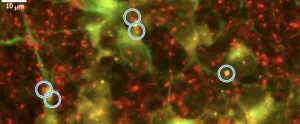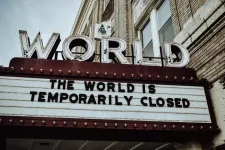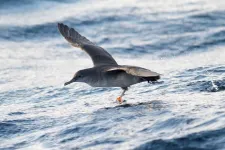(Press-News.org) LA JOLLA, CA — Nerve cells in the brain demand an enormous amount of energy to survive and maintain their connections for communicating with other nerve cells. In Alzheimer’s disease, the ability to make energy is compromised, and the connections between nerve cells (called synapses) eventually come apart and wither, causing new memories to fade and fail.
A Scripps Research team, reporting in the journal Advanced Science on January 18, 2024, has now identified the energetic reactions in brain cells that malfunction and lead to neurodegeneration. By using a small molecule to address the malfunction, which occurred in the mitochondria—the cell’s major energy producers—the researchers showed that many neuron-to-neuron connections were successfully restored in nerve cell models derived from human Alzheimer’s patient stem cells. These findings highlight that improving mitochondrial metabolism could be a promising therapeutic target for Alzheimer’s and related disorders.
“We thought that if we could repair metabolic activity in the mitochondria, maybe we could salvage the energy production,” says senior author Stuart Lipton, MD, PhD, Step Family Foundation Endowed Professor and Co-Director of the Neurodegeneration New Medicines Center at Scripps Research, and a clinical neurologist in La Jolla, Calif. “In using human neurons derived from people with Alzheimer’s, protecting the energy levels was sufficient to rescue a large number of neuronal connections.”
In the new study, Lipton and his team found a block in the enzymes that make energy due to an abnormal tag of nitrogen (N) and oxygen (O) atoms onto a sulfur (S) atom, all together forming a dysfunctional “SNO” enzyme. This reaction is termed S-nitrosylation, and the team demonstrated that a virtual “SNO-Storm” of these reactions occurred in the Alzheimer’s brain neurons.
Lipton and his colleagues initially made the discovery of the “SNO-tag” on energy enzymes by comparing human brains (obtained at autopsy from people with Alzheimer’s disease) to those with no brain disease. The researchers subsequently generated nerve cells from stem cells derived from skin biopsies of people with and without a genetic mutation that causes Alzheimer’s disease. Then, using a series of metabolic labels and an oxygen-measuring apparatus, they calculated cellular energy production and identified unique deficits in the Alzheimer’s nerve cells compared to controls.
The researchers found the neurons had a disrupted Krebs cycle—the cellular process in mitochondria that produces most of the body’s crucial molecular power source, ATP. The team pinpointed a bottleneck (or block) in the step where a key molecule is formed: succinate, which drives much of the subsequent production of ATP. In the study, the bottleneck inhibited the mitochondria’s ability to produce the energy needed to sustain neurons and their numerous connections.
The researchers hypothesized that if they could supply some of the missing succinate molecules, they might be able to restore energy production—essentially jumpstarting the stalled mitochondrial Krebs cycle. Since succinate does not easily travel in or out of cells, they used an analog that could better pass through nerve cell membranes. The strategy worked, repairing up to three quarters of the synapses that had been lost, while preventing further decline.
“Succinate is not a compound that people can now take as a treatment, but it’s proof-of-principle that you can re-energize the Krebs cycle,” says Lipton. “The beauty of the study is that we were able to show this in living nerve cells derived from Alzheimer’s patients, but we still have to come up with a much better compound in order to develop an effective drug for humans to take.”
Lipton has a history of developing FDA-approved drugs for Alzheimer’s disease, such as Namenda®, and acknowledges that much more work is needed here to produce an additional energy-preserving drug that is both safe and effective in humans. His lab will continue to pursue the mitochondrial Krebs cycle as a promising therapeutic target in the hopes they can restore neuronal connectivity in patients with Alzheimer’s, thereby stopping disease progression and enhancing cognitive function.
In addition to Lipton, authors of the study, “Metabolic Bypass Rescues Aberrant S-Nitrosylation-Induced TCA Cycle Inhibition and Synapse Loss in Alzheimer’s Disease Human Neurons,” include Alexander Andreyev, Nima Dolatabadi, Xu Zhang, Melissa Luevanos, Mayra Blanco, Christine Baal, Ivan Putra, and Tomohiro Nakamura of Scripps Research; Hongmei Yang and Steven Tannenbaum of MIT; and Paschalis-Thomas Doulias and Harry Ischiropoulos of the Perelman School of Medicine at the University of Pennsylvania.
This work was supported in part by funding from the National Institutes of Health (R01 AG061845, R61 NS122098, RF1 NS123298, R35 AG071734, RF1 AG057409, R56 AG065372, R01 DA048882, DP1 DA041722, and R01 AG056259).
About Scripps Research
Scripps Research is an independent, nonprofit biomedical institute ranked one of the most influential in the world for its impact on innovation by Nature Index. We are advancing human health through profound discoveries that address pressing medical concerns around the globe. Our drug discovery and development division, Calibr, works hand-in-hand with scientists across disciplines to bring new medicines to patients as quickly and efficiently as possible, while teams at Scripps Research Translational Institute harness genomics, digital medicine and cutting-edge informatics to understand individual health and render more effective healthcare. Scripps Research also trains the next generation of leading scientists at our Skaggs Graduate School, consistently named among the top 10 US programs for chemistry and biological sciences. Learn more at www.scripps.edu.
END
Re-energizing mitochondria to treat Alzheimer’s disease
Scripps Research team restored neuron-to-neuron connections in human cells.
2024-01-29
ELSE PRESS RELEASES FROM THIS DATE:
Rice scientists pull off quantum coup
2024-01-29
HOUSTON – (Jan. 29, 2023) – Rice University scientists have discovered a first-of-its-kind material, a 3D crystalline metal in which quantum correlations and the geometry of the crystal structure combine to frustrate the movement of electrons and lock them in place.
The find is detailed in a study published in Nature Physics. The paper also describes the theoretical design principle and experimental methodology that guided the research team to the material. One part copper, two parts vanadium and four parts sulfur, the alloy features a 3D pyrochlore lattice consisting ...
Spatial model predicts bumblebee exposure to pesticide use
2024-01-29
It has long been known that agricultural pesticides are one of the greatest threats to bees and other essential pollinators. What farmers have lacked is an understanding of how different pesticides, applied at various times on a variety of crops, affect the risk of exposure to bees living near the fields.
Researchers have drawn from real-world data to try to address this gap, developing and testing a spatial model for predicting pesticide exposure in bumblebees. The journal Science of the Total Environment published the work, based on the interactions of the yellow-faced bumblebee (Bombus vosnesenskii) ...
A firm eye on the proboscis
2024-01-29
EMBARGOED UNTIL MONDAY, 29 JANUARY 2024, 21:00 CET (20:00 LONDON TIME, 15:00 U.S. EASTERN TIME)
Have you ever seen a hummingbird hawk moth? When people encounter this moth for the first time, they are usually intrigued: Looking like a cross between a butterfly and a bird – hence the name – this animal has the amazing ability to hover like a helicopter for long periods. On closer inspection, another feature of the hummingbird hawk moth quickly catches the eye: the spiralling curled proboscis, which is as long as the entire animal.
The moth uses its proboscis ...
Viral protein fragments may unlock mystery behind serious COVID-19 outcomes
2024-01-29
There are many lingering mysteries from the COVID-19 pandemic. For instance, why does SARS-CoV-2, the virus behind the disease, cause severe symptoms in some patients, while many other coronaviruses don’t? And what causes strange symptoms to persist even after the infection has been cleared from a person’s system?
The world may now have the beginning of answers. In a study published today in the journal Proceedings of the National Academy of Sciences, a UCLA-led multidisciplinary research team explores one way that COVID-19 turns the ...
Endangered seabird shows surprising individual flexibility to adapt to climate change
2024-01-29
New research finds that individual behavioural flexibility and not evolutionary selection is driving the northward shift of Balearic shearwaters.
The findings were revealed through a decade-long study which tagged individual birds.
The results indicate that individual animals may have greater behavioural flexibility to respond to climate change impacts than previously thought.
How individual animals respond to climate change is key to whether populations will persist or go extinct. Many species are shifting their ranges as the environment warms, but up to now the mechanisms underlying ...
Spacing characteristics between vegetation could be a warning sign of degrading dryland ecosystems - study
2024-01-29
Scientists have found that the spatial arrangement of plants in drylands can be a sign of the environment degrading, according to a new study.
One of the iconic features of drylands is the striking appearance of islands of plants surrounded by bare soil. This spatial structure of arid vegetation has long fascinated scientists, but now a new study published in Proceedings of the National Academy of Sciences, has shed new light on why these plants group in this way.
An international team of scientists, including from the University of Birmingham, combined field data from 115 sites around the world, and used mathematical models and remote sensing to build a picture of how the ...
Researchers spying for signs of life among exoplanet atmospheres
2024-01-29
COLUMBUS, Ohio – The next generation of advanced telescopes could sharpen the hunt for potential extraterrestrial life by closely scrutinizing the atmospheres of nearby exoplanets, new research suggests.
The next generation of advanced telescopes could sharpen the hunt for potential extraterrestrial life by closely scrutinizing the atmospheres of nearby exoplanets, new research suggests.
Published recently in The Astronomical Journal, a new paper details how a team of astronomers from The Ohio State University examined upcoming telescopes’ ability to detect chemical ...
People are inclined to hide a contagious illness while around others, research shows
2024-01-29
A startling number of people conceal an infectious illness to avoid missing work, travel, or social events, new research at the University of Michigan suggests.
The findings are reported in Psychological Science, a journal of the Association for Psychological Science. Across a series of studies involving healthy and sick adults, 75% of the 4,110 participants said they had either hidden an infectious illness from others at least once or might do so in the future. Many participants reported boarding planes, going on dates, and engaging in other social interactions while secretly sick. More than 61% of healthcare workers participating in the study also ...
Racial and ethnic differences in hypertension-related telehealth
2024-01-29
A new study in the peer-reviewed journal Telemedicine and e-Health found that hypertension management via telehealth increased among Medicaid recipients regardless of race and ethnicity during the COVID-19 pandemic. Click here to read the article now.
Jun Soo Lee, PhD, from the Centers for Disease Control and Prevention (CDC), and coauthors, reported that from February-April 2023, the number of hypertension-related telehealth outpatient visits per 100 persons increased from 0.01 to 6.13, and the number of hypertension-related in-person visits decreased from 61.88 to 52.63.
The investigators ...
Henry Ford Health helps advance precision medicine research in Michigan
2024-01-29
Michiganders will continue to have the opportunity to advance medical research aimed at advancing individualized health care through a renewed award to Henry Ford Health + Michigan State University Health Sciences from the National Institutes of Health’s (NIH) All of Us Research Program. The award includes $18.3 million in initial funding to support a consortium of 8 health care provider organizations with a presence in 16 states.
Henry Ford has led the consortium since 2017. The renewed award allows participation to continue until at least 2028. The multimillion-dollar multi-year award represents the largest NIH research grant in Henry Ford’s 108-year history.
All ...
LAST 30 PRESS RELEASES:
Injectable breast ‘implant’ offers alternative to traditional surgeries
Neuroscientists devise formulas to measure multilingualism
New prostate cancer trial seeks to reduce toxicity without sacrificing efficacy
Geometry shapes life
A CRISPR screen reveals many previously unrecognized genes required for brain development and a new neurodevelopmental disorder
Hot flush treatment has anti-breast cancer activity, study finds
Securing AI systems against growing cybersecurity threats
Longest observation of an active solar region
Why nail-biting, procrastination and other self-sabotaging behaviors are rooted in survival instincts
Regional variations in mechanical properties of porcine leptomeninges
Artificial empathy in therapy and healthcare: advancements in interpersonal interaction technologies
Why some brains switch gears more efficiently than others
UVA’s Jundong Li wins ICDM’S 2025 Tao Li Award for data mining, machine learning
UVA’s low-power, high-performance computer power player Mircea Stan earns National Academy of Inventors fellowship
Not playing by the rules: USU researcher explores filamentous algae dynamics in rivers
Do our body clocks influence our risk of dementia?
Anthropologists offer new evidence of bipedalism in long-debated fossil discovery
Safer receipt paper from wood
Dosage-sensitive genes suggest no whole-genome duplications in ancestral angiosperm
First ancient human herpesvirus genomes document their deep history with humans
Why Some Bacteria Survive Antibiotics and How to Stop Them - New study reveals that bacteria can survive antibiotic treatment through two fundamentally different “shutdown modes”
UCLA study links scar healing to dangerous placenta condition
CHANGE-seq-BE finds off-target changes in the genome from base editors
The Journal of Nuclear Medicine Ahead-of-Print Tip Sheet: January 2, 2026
Delayed or absent first dose of measles, mumps, and rubella vaccination
Trends in US preterm birth rates by household income and race and ethnicity
Study identifies potential biomarker linked to progression and brain inflammation in multiple sclerosis
Many mothers in Norway do not show up for postnatal check-ups
Researchers want to find out why quick clay is so unstable
Superradiant spins show teamwork at the quantum scale
[Press-News.org] Re-energizing mitochondria to treat Alzheimer’s diseaseScripps Research team restored neuron-to-neuron connections in human cells.







